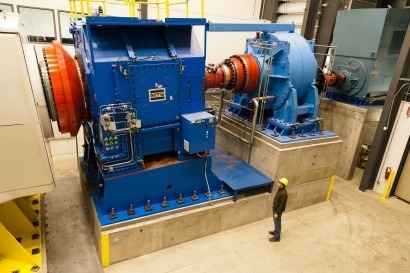
The $20 million facility enables NREL to work closely with industry engineers to enhance the drive trains and other electrical systems in the country's largest land based wind turbines. The dynamometer is also connected to a controllable grid interface that can stimulate the power grid and help system engineers better understand how wind turbines react to grid disturbances.
In a typical dynamometer test, a powerful motor replaces the rotor and blades of a wind turbine. The testing focuses on the mechanical and electrical power-producing systems of a wind turbine including gearboxes, power converters, bearings, and control systems. NREL's new facility uses a hydraulic device that simulates the rotation and bending that a wind turbine rotor places on a drivetrain. Only a handful of test facilities in the world have this dual capability; drivetrain testing under a rotational load only is the current standard for the industry.
The new Dynamometer Test Facility was funded by a grant from the Energy Department and the American Recovery and Investment Act (ARRA).
“Although wind turbines are producing an increasing percentage of Americans' electricity, there is still room to improve the reliability of the mechanical and electrical power systems, which in turn, helps drive down the cost of wind energy” said NWTC Director Fort Felker.
According to Jose Zayas, Director of DOE’s Wind & Water Technologies Office, facilities like the new NREL dynamometer will be instrumental in evaluating new technologies as wind developers install larger turbines. This will enable more clean, reliable electricity to be delivered to US consumers while also ensuring reliability and reducing both risk and costs.
For additional information:

